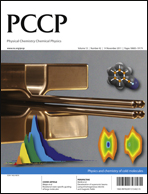Trapping cold molecular hydrogen
Abstract
Translationally cold H2 molecules excited to non-penetrating |MJ| = 3 Rydberg states of principal quantum number in the range 21–37 have been decelerated and trapped using time-dependent inhomogeneous electric fields. The |MJ| = 3 Rydberg states were prepared from the X 1Σ+g(v = 0, J = 0) ground state using a resonant three- states and of avoided crossings between Rydberg–Stark states with different values of |MJ|. The calculated Stark maps and probabilities for diabatic traversal of the avoided crossings were used as input to Monte-Carlo particle-trajectory simulations. These simulations provide a quantitatively satisfactory description of the experimental data and demonstrate that particle loss caused by adiabatic traversals of avoided crossings between adjacent |MJ| = 3 Stark states of H2 is small at principal quantum numbers beyond n = 25. The main source of trap losses was found to be from collisional processes. Predissociation following the absorption of blackbody radiation is estimated to be the second most important trap-loss mechanism at room temperature, and trap loss by spontaneous emission is negligible under our experimental conditions.
states and of avoided crossings between Rydberg–Stark states with different values of |MJ|. The calculated Stark maps and probabilities for diabatic traversal of the avoided crossings were used as input to Monte-Carlo particle-trajectory simulations. These simulations provide a quantitatively satisfactory description of the experimental data and demonstrate that particle loss caused by adiabatic traversals of avoided crossings between adjacent |MJ| = 3 Stark states of H2 is small at principal quantum numbers beyond n = 25. The main source of trap losses was found to be from collisional processes. Predissociation following the absorption of blackbody radiation is estimated to be the second most important trap-loss mechanism at room temperature, and trap loss by spontaneous emission is negligible under our experimental conditions.

- This article is part of the themed collection: Physics and chemistry of cold molecules

 Please wait while we load your content...
Please wait while we load your content...